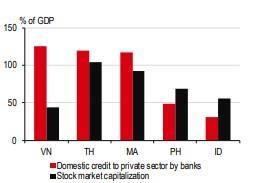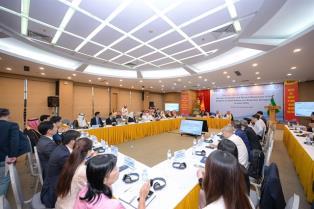Anchored by Prime Minister Phạm Minh Chính’s net-zero commitment by 2050 and driven by global climate imperatives, the energy sector is rapidly transforming, creating new investment and innovation avenues.
HÀ NỘI — As Việt Nam accelerates its transition toward a low-carbon future, the restructuring of the national energy supply chain is emerging as both a necessity and a strategic opportunity.
The rise of decentralised solar farms and smart grids is reshaping national planning and the business landscape, urging enterprises to play a key role in this evolving value chain. Achieving this potential requires enabling policies, accessible financing and a supportive innovation ecosystem.
Leading experts Dr Ngô Đức Lâm, Associate Professor Dr Ngô Trí Long (former director of the Ministry of Finance's Price Market Research Institute) and Phạm Anh Cường, founder and CEO of the Bestb start-up ecosystem, shared their insights about the issues.

Why is the energy supply chain increasingly vital to Việt Nam’s sustainable development strategy?
Dr Lâm: The global energy sector is undergoing a dramatic transformation driven by climate change and the urgent need to reduce greenhouse gas emissions. Việt Nam is no exception. Our commitment to net-zero emissions by 2050, announced at COP26, has catalysed a nationwide energy transition. This shift, from fossil fuels toward renewables like solar, wind and biomass, not only enhances energy security but also opens a new chapter for businesses to innovate and grow within the energy supply chain.
How is the energy supply chain in Việt Nam structured, and what has changed in recent years?
Dr Lâm: Traditionally, Việt Nam’s power system relied heavily on coal, hydro and gas.
Before 2020, renewables played a minor role. However, with the introduction of feed-in tariffs (FITs) and policy backing, renewable energy, especially solar and wind, has rapidly expanded.
By 2020, renewables accounted for nearly 20 per cent of the country’s installed power capacity. The adjusted Power Development Plan VIII (2025) sets ambitious targets: 25–31 per cent solar and up to 17 per cent wind by 2030.
This structural shift is creating diverse entry points for both large and small enterprises across generation, transmission, storage and distribution.

What role do Vietnamese enterprises play in the energy transition?
Dr Long: Enterprises are the backbone of the energy value chain, from exploration and generation to distribution and end-use.
In traditional energy, State-owned giants like Vietnam Electricity (EVN), PetroVietnam (PVN) and Vinacomin (TKV) dominate.
But in renewables, private firms now account for nearly 80 per cent of solar power capacity. Yet, despite this central role, many companies, especially small and medium-sized enterprises (SMEs), face barriers like high capital costs, inconsistent policy signals and limited access to green finance.
Unlocking their potential is essential to meeting Việt Nam’s energy and climate goals.
What financial hurdles do energy enterprises currently face?
Dr Long: There are several major constraints.
Financing renewables requires large, long-term investments, but only 15–20 per cent of firms can access preferential credit.
Domestic interest rates for long-term loans are often above 10 per cent, with stringent collateral requirements.
Compounding this are uncertainties in the power purchase agreements (PPAs), especially after the expiration of FITs, leaving some US$13 billion in renewable investment exposed to payment risks.
Without clear, enforceable policies and credit guarantees, many banks are reluctant to lend.

Is there a way forward for Vietnamese SMEs and start-ups in this space?
Cường: Absolutely. Start-ups are emerging as crucial players in energy innovation, whether in rooftop solar, electric vehicles or smart grids. Take Alternō, a Vietnamese start-up using sand-based thermal batteries, or SmartSolar, which offers solar solutions with zero upfront costs to SMEs.
Yet, the ecosystem remains fragmented. We need sandbox environments for testing new business models, better links between start-ups, investors and research institutions, and targeted support mechanisms.
With Việt Nam’s young, tech-savvy workforce and abundant renewable potential, the opportunities are real.
What policy mechanisms are needed to support enterprise participation in the energy supply chain?
Dr Long: We must develop a robust financial and legal framework. Key steps include establishing a National Energy Transition Fund to provide concessional loans, credit guarantees and technical assistance while finalising a green taxonomy for project classification and ESG standards.
We also need to introduce green credit programmes, facilitate green bond issuance and create a standardised, bankable PPA framework to reduce investor uncertainty.
International models, like Germany’s 200 billion euro Climate and Transformation Fund or Korea’s Green Development Banks, offer valuable lessons for Việt Nam.
What are some specific opportunities in the energy value chain for Vietnamese enterprises?
Dr Lâm: Opportunities are vast, particularly due to the decentralised nature of renewable energy.
Smaller-scale solar and wind projects, for example, align well with local companies’ financial and operational capacities. Businesses can engage in construction, EPC services, equipment supply and digital management systems (like SCADA or AI-based grid optimisation).
The push for competitive electricity markets, moving toward retail electricity competition, also enables firms to enter distribution, trading and customer services.
What are the key barriers hindering enterprise participation, and how can they be resolved?
Dr Lâm: The biggest challenges remain policy incoherence and administrative complexity.
Developers face delays in land access, unclear tax incentives and ambiguous approval processes. Meanwhile, outdated legal provisions, such as those in the Land Law or Investment Law, fail to reflect the fast-evolving needs of energy projects. These should be revised urgently.
Additionally, capacity-building is vital. The supply chain demands specialised technical expertise that many SMEs lack.
What long-term outlook do you see for Việt Nam’s energy sector and its enterprise ecosystem?
Cường: If we align policy, finance and innovation, Việt Nam could become a regional leader in clean energy.
But we must act fast. Establishing a coherent start-up ecosystem, mobilising domestic and international capital and embracing technological disruption will be key.
Programmes like the proposed Energy Innovation Partnership linking Government, investors, researchers and entrepreneurs could catalyse this transformation. As investors, we’re ready. Now we need the system to follow through. — BIZHUB/VNS





